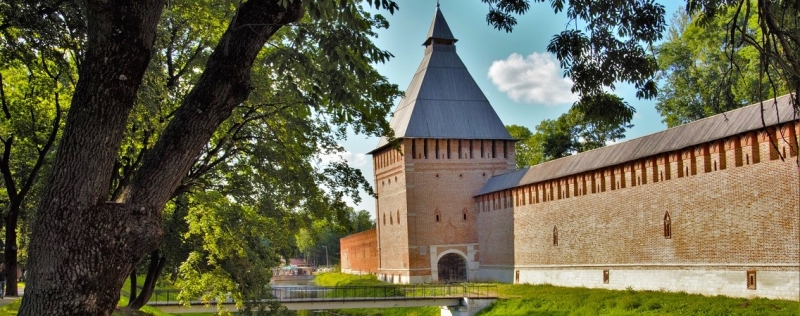
Smolensk for many centuries was considered the main key to the heart of Russia, since it was the first defensive point on the western borders of the country. Here you will see many monuments, richly decorated cathedrals and sections of fortress walls spread across the city center, as well as locations where you can have a fun and active time. We have prepared a route for a mini-trip to Smolensk for the weekend.
How to get there
There is no airport in Smolensk, so the most convenient way to get to the city is by car or train. From Moscow you need to follow the M-1 Belarus highway (Minsk Highway), the journey will take five hours. By train from Moscow it takes about four hours on the Lastochka, a one-way ticket costs from 1,200 rubles*.
Train No. 087A runs from St. Petersburg several times a week to Smolensk, the journey time is approximately 16 hours, and the ticket price starts from 1,400 rubles*.
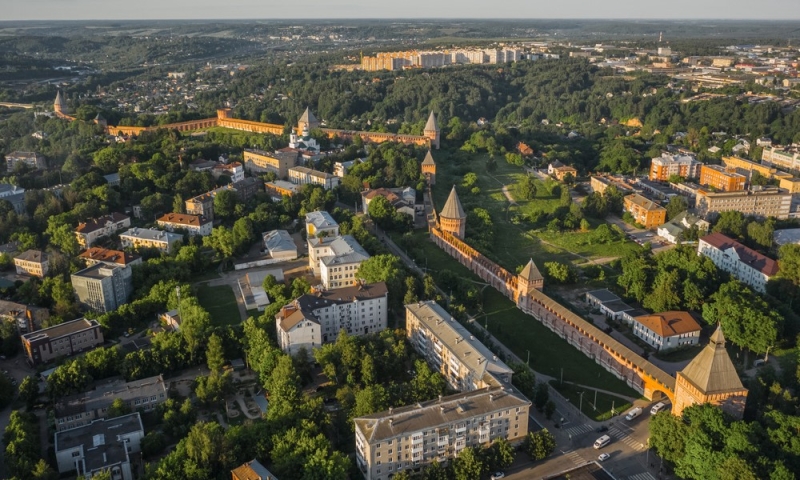
Where to stay
- In the four-star designer loft-style hotel SandS of Time with handmade furniture and a private kitchenette in each room (rating 9.5) – from 2,200 rubles* per night.
- In the three-star Bridge Hotel with stylish rooms and delicious breakfasts, a 10-minute walk from the railway station (score 9.5) – from 2,600 rubles* per night.
- In the four-star Usadba hotel with spacious family rooms in a classic style, a library and a Finnish sauna with a swimming pool (rating 9.5) – from 4,600 rubles* per night.
- In the four-star Pestrikov Hotel, located in a historical building from 1876 with unusual decorative elements from the eclectic period (score 9.6) – from 6,800 rubles* per room.
What to see on the first day
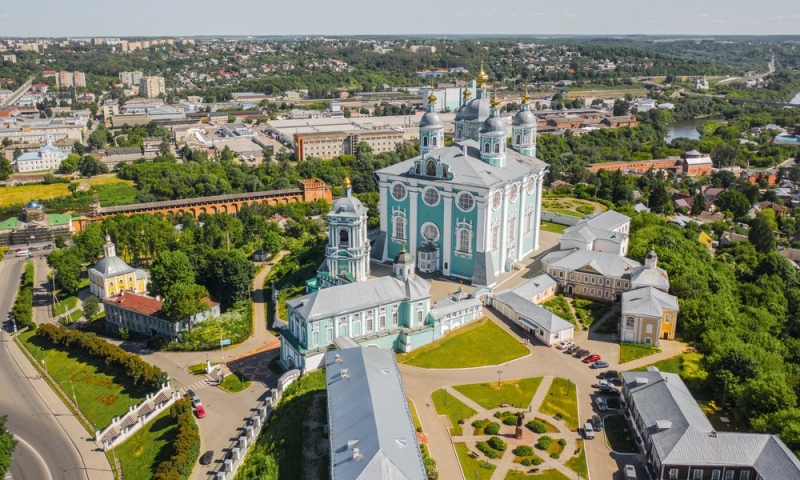
The name “shield of Russia” was assigned to Smolensk. This is a border city in the north-west of the country, which for many centuries defended Moscow from enemy invasions of the Tatar-Mongols, French, Poles and Germans. Defensive structures, fortress walls, museums and monuments – all this reminds of the military past. On the other hand, Smolensk is very cozy and compact, there are picturesque parks and hilly streets with European buildings.
Smolenskaya embankment
It is more convenient to start exploring the city from the embankment, which stretches along the Dnieper. This is a landscaped pedestrian promenade with places to rest. Look at the powerful fortress walls remaining from the ancient Kremlin, the four-meter bronze monument to Prince Vladimir and the Church of St. John the Evangelist, rising on a low hill.
Smolensk fortress wall
A grandiose defensive structure was built in the city by order of Tsar Boris Godunov under the leadership of the architect Fyodor Kon, to whom a monument was erected in the center of Smolensk. In six years, more than six km of fortress walls and about 40 watchtowers were erected, but only isolated sections with a total length of 3.5 km and 17 towers have survived to this day. You can see them in different parts of the city: for example, on the Dnieper embankment, next to the Lopatinsky Garden and along the Memorial Square of Heroes.
To look at all the preserved sections of the fortress in the city and learn the most interesting facts from its history, go on the excursion “Along the Smolensk Fortress Wall”.
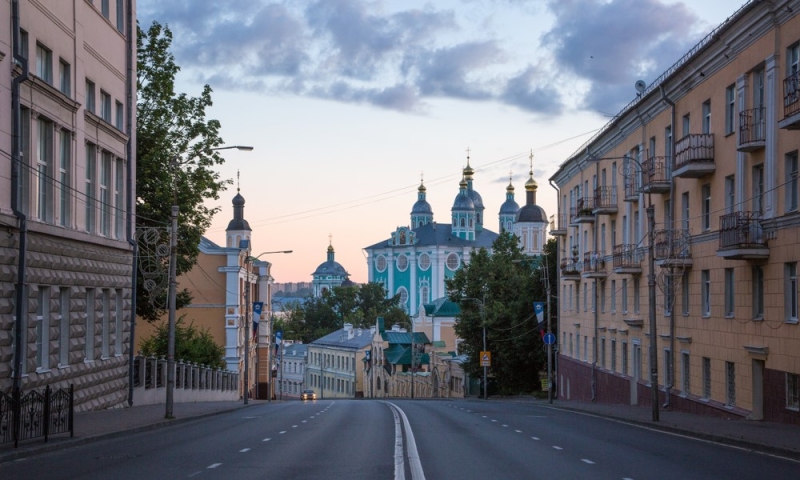
Cathedral Hill
On a high hill near the embankment rises the main temple of Smolensk – the Holy Assumption Cathedral. It is surrounded by massive white stone walls, a bell tower, small churches and a number of religious buildings, and this entire area is called Cathedral Hill. The temple was built in the 12th century by order of Vladimir Monomakh, but after several wars it was rebuilt more than once and acquired its final appearance only at the turn of the 17th-18th centuries.
The bright turquoise building is decorated with golden domes, and inside there is a 31-meter gilded iconostasis and an interior in the Kyiv Baroque style. The architectural composition can be seen from almost anywhere in the historical center of Smolensk, because the height of the temple together with the crosses reaches 72 m. Interestingly, the bell tower here is lower than the cathedral itself – about 50 m.
Bolshaya Sovetskaya Street
From the Dnieper embankment, past the Cathedral Hill, Bolshaya Sovetskaya Street, wide and rich in architectural monuments, stretches. Here are elegant 19th-century mansions that belonged to the city’s richest residents, small churches, antique shops and restaurants.
Walking down the street, pay attention to the three-story mansion with an ancient Dutch clock protruding from the facade of the building (house 16) or to the former merchant city estate in the Art Nouveau style with an oval window on two floors, faceted bay windows and stucco garlands (house 20).
Museum “Smolensk region during the Great Patriotic War”
The fate of Smolensk as a city bordering Eastern Europe is inextricably linked with its military past. Therefore, it is not surprising that the most visited city museum is dedicated to the period of occupation, partisan movement and liberation of the Smolensk region in 1941–1945. It is located in the Heroes’ Memory Square opposite the majestic memorial with bronze eagles.
What to see on the second day
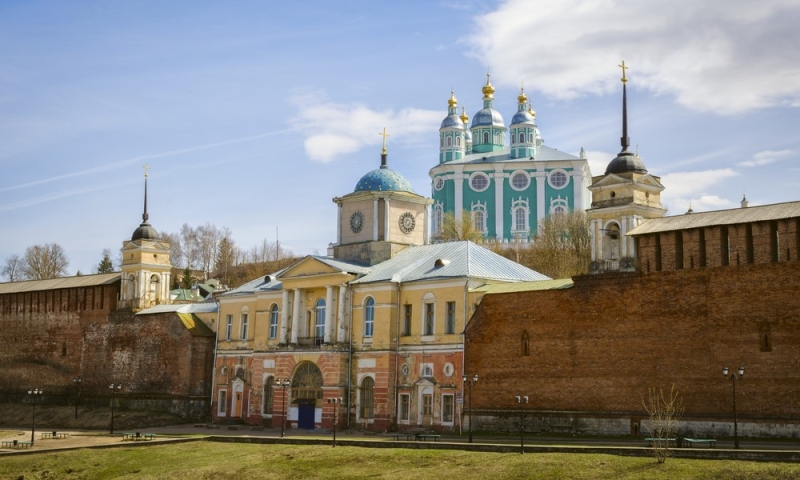
Lopatinsky Garden
At the end of the 19th century, Alexander Lopatin, who was then the governor of the city, built a huge park of metropolitan scale with his personal savings. Now it is called the Lopatinsky Garden and there is something to see here besides the abundance of greenery. Walk next to the cannons that remain from the time of Napoleon, or along the underground passages and ramparts decorated with a snow-white lion and lioness.
In the children’s part of the garden there are playgrounds, places for recreation, a Ferris wheel and an entire amusement park where both adults and children will find entertainment. Recently, an interesting interactive space opened in the garden – an inverted castle. On the first floor, the rooms are decorated in the style of the fairy tale “Emerald City”, and on the second floor, visitors find themselves in mystical forests and abandoned castles, where witches, goblin and other mythical creatures live.
City forge of the 17th century
The museum is located in the oldest surviving civil building in Smolensk. The small one-story house was built in the 17th century and almost immediately became the city’s blacksmith shop. Now there are keys, locks, edged weapons, dishes and other products from past centuries. And a real blacksmith in a craftsman’s costume shows how to use an anvil, tools and heat forged parts in a forge.
Creative workshop “Smolensk Izba”
Guests of the city of any age will be interested in visiting unusual master classes here. You will learn how to weave from bast, draw with threads and chocolate, make Slavic amulets or Russian folk toys. The workshop staff fascinatingly talk about the history of traditional crafts and folk art. There is a souvenir shop in the hut where you can buy handmade ceramic and clay products.
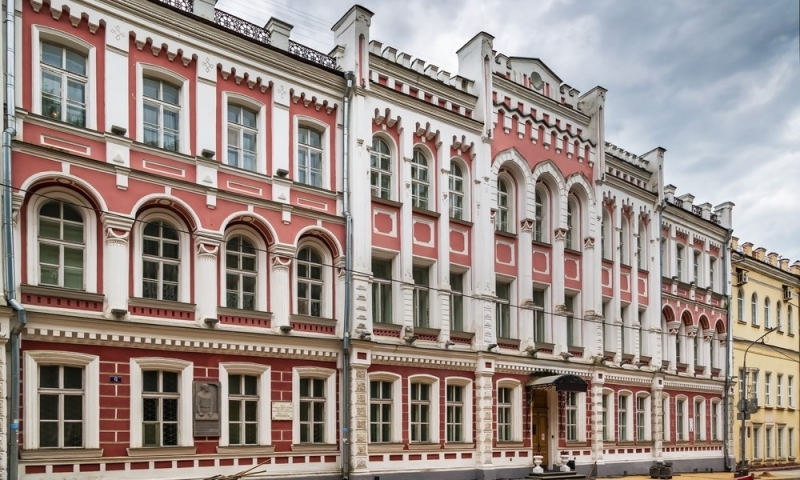
Entertainment complex and eco-farm “Bremen”
20 km from Smolensk, surrounded by dense forests and Lake Penesnar, there is a modern recreation center. Here you will be invited to spend active time in nature – learn to ride buggies, ATVs and motor sleighs, and in good weather play football, volleyball or laser tag. Adults and older children can overcome an obstacle course, go karting, shoot with a bow, or shoot targets with a crossbow. Kids will be interested in visiting an eco-farm with well-groomed domestic animals, taking a boat ride on the lake or running along the sandy beach.
Historical and architectural complex “Teremok”
18 km from Smolensk near the village of Flenovo there is the former Tenishev estate – Talashkino, built at the beginning of the 20th century. Famous artists, composers and musicians loved to relax here. The fairy-tale house “Teremok” attracts a lot of attention on the territory of the complex. The massive log building is considered a masterpiece of Russian architecture. Look at the skillfully sawn and delicately carved details: windows, trim, doors and cornices. The facades are painted in bright colors and decorated with fairy-tale motifs.
Inside there is a small museum dedicated to Talashkin masters. Furniture items, works by M. A. Vrubel in watercolor technique, ceramics by N. K. Roerich and painted balalaikas, which were exhibits at the World Exhibition in Paris, are exhibited here. Next to the “Teremk” and the central building of the estate there is the Church of the Holy Spirit and a peasant school, which you can explore on your own or during an exciting excursion “Russian Athens – a creative estate in Talashkino-Flenovo.”
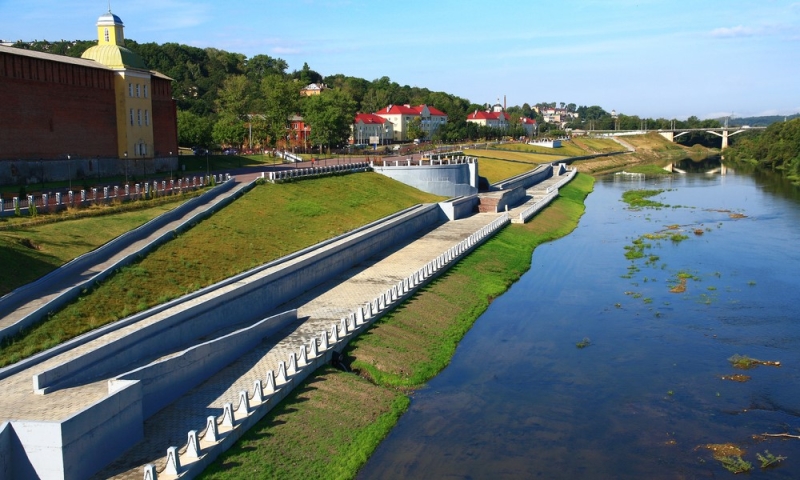
What and where to eat
- Smolensk lapuns, kulebyaki, pies, cabbage soup, potato pancakes and hearty pancakes in the cafe “Russian Court”, inside and outside reminiscent of a fairy-tale tower (street October Revolution, 1B).
- Sashimi, rolls, seafood soups and other dishes of Pan-Asian cuisine in a restaurant with an open kitchen Zonda (Bolshaya Sovetskaya Street, 18/18).
- Pasta, salmon and beef steaks, signature cocktails and warming drinks in the pub “Mayakovsky”, where live music concerts take place every weekend (street Mayakovsky, 3).
- Khinkali, dolma, khachapuri, grilled meat dishes and amber wines in a Georgian restaurant “Guru” (Bolshaya Sovetskaya Street, 20) .
- Hearty breakfasts, hand-made dumplings and dumplings in the café-restaurant “Marusya”, which is located in an old house with an authentic interior (Przhevalsky Street, 2).
- Crayfish, mussels and shrimps of various types of frying, oysters and snails, octopus tentacles and phalanxes of Kamchatka crab in the clam restaurant “Claws and Tails” (Gagarin Avenue, 8).
Online hotel bookings are possible on OneTwoTrip. Compare prices, read reviews and choose the best properties for your trip.
*Prices are current at the time of publication.

